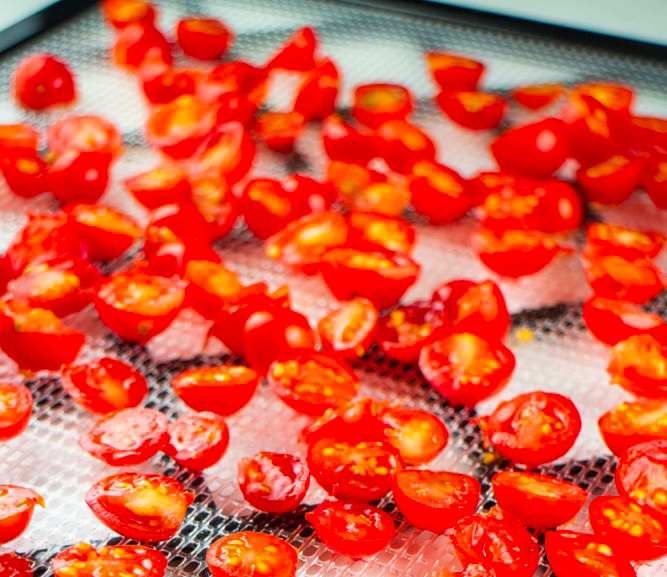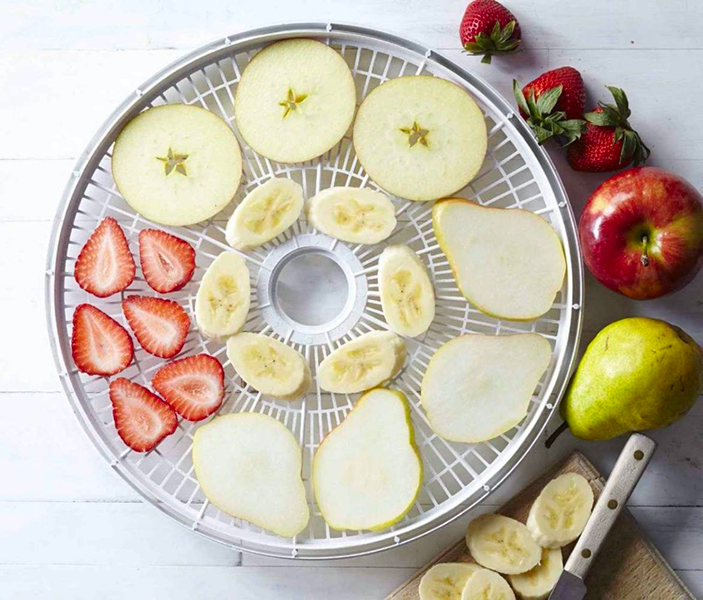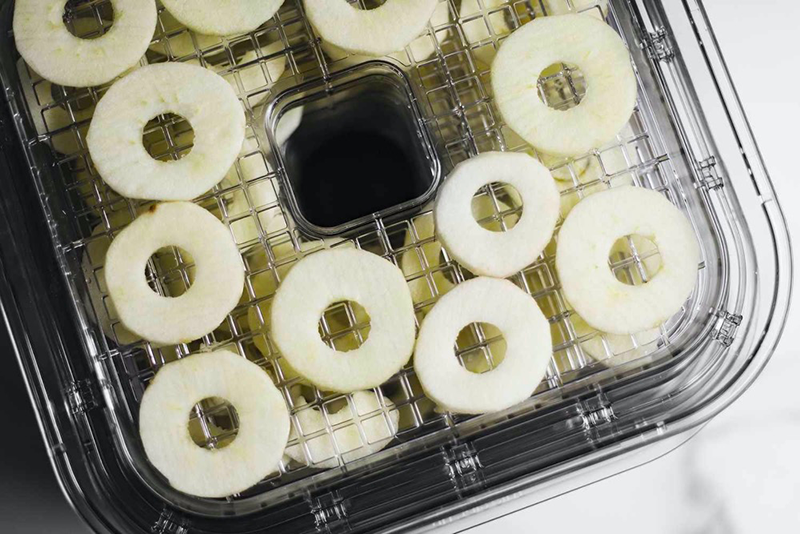
Content Menu
● Understanding Food Dehydration
>> How Does a Food Dehydrator Work?
● Benefits of Using a Food Dehydrator
>> 1. Nutrient Preservation
>> 2. Extended Shelf Life
>> 3. Cost-Effectiveness
>> 4. Healthy Snacking
>> 5. Versatility
● How to Dehydrate Fruits and Vegetables
● Common Fruits and Vegetables for Dehydration
● Techniques for Successful Dehydration
● The Science Behind Dehydration
● Popular Uses for Dehydrated Foods
● Storing Dehydrated Foods
● Conclusion
● FAQs
>> 1. What types of foods can I dehydrate?
>> 2. How long does it take to dehydrate food?
>> 3. Do I need to pre-treat all fruits before dehydrating?
>> 4. Can I use my oven instead of a dehydrator?
>> 5. How should I store dehydrated foods?
● Citations:
Food preservation is essential in today's fast-paced world, where food waste is a significant concern. One of the most effective methods for preserving fruits and vegetables is through dehydration. This article explores how a food dehydrator works, its benefits, and tips for successful food dehydration.

Understanding Food Dehydration
Dehydration is the process of removing moisture from food, which inhibits the growth of bacteria, yeast, and molds. By eliminating moisture, food becomes lightweight, compact, and shelf-stable. The dehydration process makes it possible to enjoy seasonal fruits and vegetables year-round.
How Does a Food Dehydrator Work?
A food dehydrator uses heat and airflow to remove moisture from food. Here are the key components:
- Heating Element: Generates heat to evaporate moisture.
- Drying Trays: Where food is placed for drying.
- Fan: Circulates hot air around the food for even drying.
- Vents: Allow moisture-laden air to escape.
The ideal temperature for dehydrating fruits and vegetables typically ranges from 125°F to 140°F (52°C to 60°C) to ensure effective moisture removal without cooking the food.
Benefits of Using a Food Dehydrator
Using a food dehydrator offers several advantages:
1. Nutrient Preservation
Dehydrating food retains most of its vitamins and minerals compared to other preservation methods like canning or freezing. For example, research shows that fresh produce loses its vitamin, mineral, and antioxidant content within a few days of refrigeration—reductions as high as 50% for some nutrients[1]. Dehydrated foods maintain their nutrients for much longer than their fresh counterparts.
2. Extended Shelf Life
Dehydrated foods can last for years when stored properly. For instance, dried fruits can have a shelf life of up to five years, while dried vegetables can last eight to ten years. This long shelf life makes dehydrated foods an excellent option for emergency preparedness or long-term storage.
3. Cost-Effectiveness
Investing in a food dehydrator can save money in the long run. Purchasing seasonal produce in bulk and dehydrating it reduces the need for expensive out-of-season items. Additionally, using a dehydrator allows you to preserve any excess food that you don't eat immediately, reducing waste[2].
4. Healthy Snacking
Dehydrated fruits and vegetables make excellent snacks that are free from preservatives and added sugars commonly found in store-bought options. They provide concentrated nutrients and flavors, making them a great choice for health-conscious individuals.
5. Versatility
Food dehydrators are versatile appliances that can be used to make fruit leathers, jerky, dried herbs, and even pet treats. You can experiment with various flavors by adding spices or marinades before dehydration.
How to Dehydrate Fruits and Vegetables
To successfully dehydrate fruits and vegetables, follow these steps:
1. Preparation: Wash and slice the produce into uniform pieces to ensure even drying.
2. Pre-treatment: Some fruits may require pre-treatment (like soaking in lemon juice) to prevent browning.
3. Loading the Dehydrator: Place the prepared food on the drying trays without overcrowding.
4. Setting the Temperature: Set your dehydrator to the appropriate temperature based on the type of food being dried.
5. Monitoring: Check periodically for doneness; most fruits should be pliable but not sticky, while vegetables should be crisp.
6. Cooling and Storing: Allow dehydrated foods to cool before storing them in airtight containers.

Common Fruits and Vegetables for Dehydration
Some popular choices for dehydration include:
- Fruits: Apples, bananas, strawberries, mangoes
- Vegetables: Tomatoes, peppers, carrots, zucchini
These items not only dehydrate well but also retain their flavors and nutrients effectively.
Techniques for Successful Dehydration
To maximize the effectiveness of your dehydration process:
- Uniform Cutting: Cut your fruits and vegetables into uniform pieces so they dehydrate evenly[9]. Thinner slices will dehydrate faster than thicker ones.
- Proper Pre-treatment: For fruits like apples or bananas that tend to brown quickly, soaking them in a solution of lemon juice or ascorbic acid can help maintain their color[8].
- Monitor Temperature: Different foods require different temperatures for optimal dehydration:
| Food Type | Recommended Temperature |
| Herbs | 95°F (35°C) |
| Vegetables | 125°F (52°C) |
| Fruits | 135°F (57°C) |
| Meats | 160°F (71°C) |
- Avoid Overcrowding: Ensure there is enough space between pieces on the drying trays to allow air circulation[9]. Overcrowding can lead to uneven drying.
The Science Behind Dehydration
Dehydrating food not only extends its shelf life but also intensifies its flavors[7]. When moisture is removed from fruits and vegetables, their natural sugars become more concentrated, resulting in a sweeter taste profile. Additionally, this process helps preserve enzymes that contribute to flavor development.
Research indicates that dried fruits and vegetables could play a role in reducing the risk of some cancers due to beneficial phytochemicals activated during dehydration[1]. Furthermore, dehydrated foods often have higher fiber content than their fresh counterparts, aiding digestion[1].
Popular Uses for Dehydrated Foods
Dehydrated foods are incredibly versatile in culinary applications:
- Snacks: Dried fruit chips or vegetable crisps make healthy snacks.
- Cooking Ingredients: Dried vegetables can be added directly into soups or stews without rehydrating first.
- Camping & Hiking: Lightweight dehydrated meals are perfect for outdoor adventures where refrigeration isn't available.
Storing Dehydrated Foods
To ensure your dehydrated foods remain safe and tasty:
- Store them in airtight containers in a cool, dark place.
- Vacuum sealing is an excellent option for long-term storage as it removes air that could lead to spoilage[8].
- Label containers with the date of dehydration so you can track freshness over time.
Conclusion
A food dehydrator is an invaluable tool for anyone looking to preserve fruits and vegetables efficiently. By understanding how it works and following best practices for dehydration, you can enjoy delicious snacks year-round while minimizing food waste. The benefits of using a food dehydrator extend beyond just preservation; they include improved nutrition retention, cost savings, versatility in culinary applications, and enhanced flavors.

FAQs
1. What types of foods can I dehydrate?
You can dehydrate a wide variety of foods including fruits (like apples and bananas), vegetables (such as tomatoes and carrots), meats (for jerky), herbs, and even dairy products.
2. How long does it take to dehydrate food?
The time required for dehydration varies based on the type of food and its moisture content. Generally, fruits take 6-12 hours while vegetables may take 4-10 hours at appropriate temperatures.
3. Do I need to pre-treat all fruits before dehydrating?
Not all fruits require pre-treatment; however, those prone to browning (like apples or bananas) benefit from soaking in lemon juice or another acidic solution before drying.
4. Can I use my oven instead of a dehydrator?
Yes, you can use an oven set at low temperatures (around 170°F) with the door slightly ajar for airflow; however, this method is less efficient than using a dedicated dehydrator.
5. How should I store dehydrated foods?
Store dehydrated foods in airtight containers in a cool, dark place to maximize shelf life. Vacuum sealing is also an excellent option for long-term storage.
Citations:
[1] https://www.webmd.com/diet/dehydrating-food-good-for-you
[2] https://www.bestbuy.com/discover-learn/10-reasons-to-buy-a-food-dehydrator/pcmcat1634332391134
[3] https://www.healthline.com/nutrition/dehydrated-food
[4] https://www.mitchellcooper.co.uk/what-is-a-dehydrator-commercial-buying-guide
[5] https://homesteadingfamily.com/preservation-101-intro-to-dehydrating-food/
[6] https://www.harmonyhousefoods.com/blog-nutritional-value-dehydrated-veggies
[7] https://www.webstaurantstore.com/guide/741/food-dehydrators-buying-guide.html
[8] https://www.freshoffthegrid.com/dehydrating-food/
[9] https://vacuumsealersunlimited.com/how-to-use-a-food-dehydrator/
[10] https://www.theseasonalhomestead.com/9-benefits-of-dehydrating-food-that-may-surprise-you/











